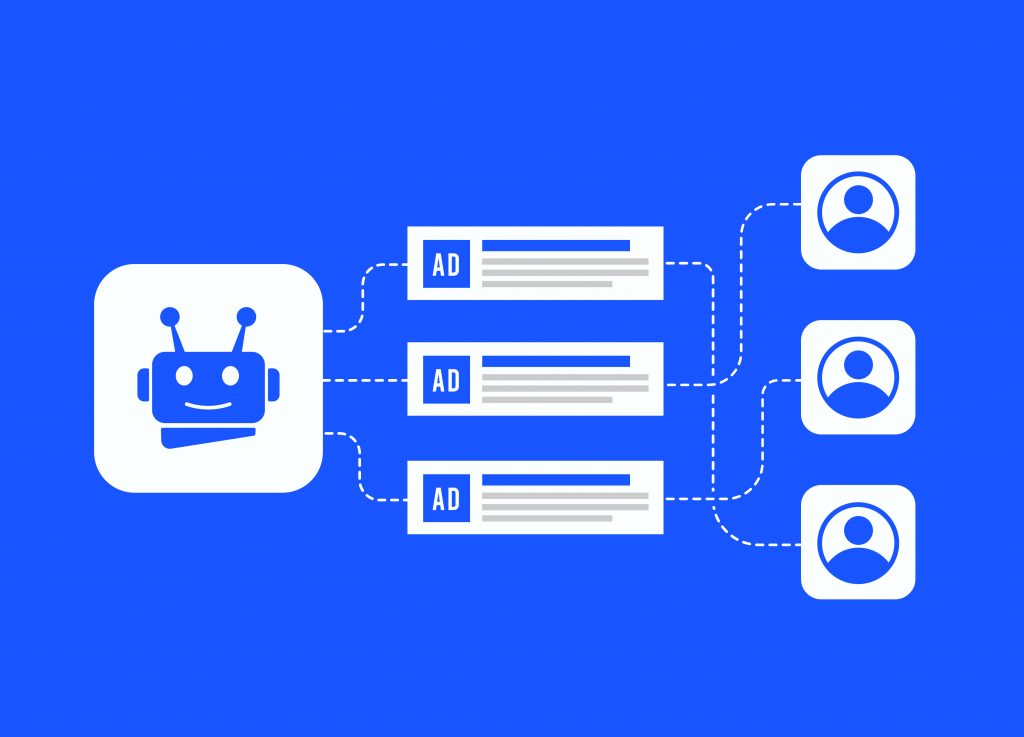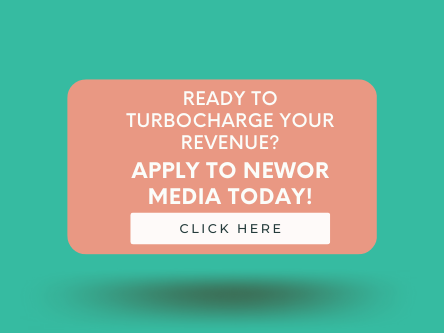
Artificial Intelligence (AI) is like a digital brain, a machine that can think and learn like a human. In advertising, AI has transformed how brands connect with their audience, making interactions more personal and efficient.
Programmatic advertising, which automates the decision-making process of ad placements using AI, has significantly transformed the advertising landscape. By leveraging AI, advertisers can analyze vast amounts of data in real-time to optimize their ad campaigns.
As AI advances, its impact on advertising grows, offering new ways to reach consumers through precision and relevance, thus setting new standards for what is possible in digital marketing.
Understanding Programmatic Advertising
Programmatic advertising automates the buying and selling of ad space in real time. It uses software to purchase digital advertising instead of traditional processes involving human negotiation and manual insertion orders.
This method relies on algorithms and data to deliver ads to the right audience at the optimal time and price, making the process faster and more efficient.
By integrating AI, programmatic advertising becomes more targeted, efficient, and adaptable to the changing dynamics of consumer behavior and market conditions.
How Does AI Enhance Programmatic Advertising?
AI plays a transformative role in programmatic advertising by making the ad delivery process more intelligent and responsive.
By harnessing AI, advertisers can automate complex decision-making processes previously reliant on human intuition and limited data analysis. This shift allows for precision and efficiency at scales previously unattainable.
Leveraging Machine Learning for Precision Targeting
Machine learning, a core component of AI, transforms how advertisers identify and reach their target audiences. It analyzes user behavior, preferences, and engagement to predict who will be most interested in a specific ad at any given moment.
This capability allows for the hyper-personalization of ads, tailoring messages to individuals rather than broad segments.
Optimizing Real-Time Bidding
AI enhances real-time bidding (RTB) by processing millions of data points to determine the best ad opportunities at the best price. AI algorithms evaluate user demographics, browsing history, and device usage to make split-second decisions on which ads to serve to which users, maximizing campaign effectiveness.
Streamlining Ad Operations
AI streamlines operational aspects of programmatic advertising by automating tasks such as bid management, ad placement, and performance optimization. This automation reduces the need for manual oversight, allowing campaigns to scale more effectively and efficiently.
Moreover, AI continuously learns and improves from campaign data, leading to increasingly refined advertising strategies.
Core AI Technologies in Programmatic Advertising
Programmatic advertising thrives on the power of AI to streamline the buying and selling of ad space, making it a more efficient and targeted endeavor.
Here’s a deeper dive into the key AI technologies driving this transformation:
Machine Learning (ML)
The engine powers programmatic advertising, and ML algorithms ingest and analyze massive datasets encompassing user behavior, demographics, browsing history, and past campaign performance. These insights empower them to:
Hyper-Targeted Audiences
Identify the most receptive users for a specific campaign, significantly increasing the likelihood of conversions. ML algorithms can create highly granular audience segments based on complex combinations of factors, ensuring laser-focused ad delivery.
Real-Time Bidding (RTB) Mastery
Automate bids on ad impressions during real-time auctions. ML considers factors like campaign budget, audience relevance, and the probability of conversion to determine optimal bids, maximizing the return on ad spend (ROAS).
Ad Creative Evolution
Analyze which ad formats, visuals, and messaging resonate best with target audiences. This data-driven approach allows for continuous improvement of ad creatives, leading to a more impactful user experience and, ultimately, better campaign performance.
Fraud Fortress
Identify and thwart fraudulent ad activity, safeguarding advertisers from wasted resources. ML algorithms can detect anomalies in data patterns that might indicate click or impression fraud, protecting budgets and ensuring campaign integrity.
Natural Language Processing (NLP)
This technology delves into the context of web pages where ads are placed. NLP ensures brand safety by preventing ads from appearing alongside inappropriate content.
Furthermore, it can personalize ad content based on the surrounding text, creating a more seamless user experience. Imagine an ad for hiking boots dynamically adjusting its description to match an article about a challenging new trail.
Computer Vision
This AI technology analyzes images and videos within ads, unlocking a new dimension of creative optimization and audience targeting. By understanding the visual elements of an ad, computer vision can identify which creative elements resonate most with specific audiences and tailor ad delivery accordingly.
For instance, an ad for athletic wear might perform better with visuals showcasing action shots compared to static product images, and computer vision can help identify this preference.
Transforming Programmatic Advertising with AI
Artificial Intelligence is reshaping programmatic advertising by injecting speed, efficiency, and precision into every aspect of the ad delivery process. By automating complex decisions, AI enables advertisers to deploy highly targeted campaigns that would be impossible at such scale and speed through manual efforts alone.
Predictive Analytics
Predictive analytics uses historical data, machine learning, and algorithms to predict future outcomes. This translates to understanding consumer behavior and anticipating actions based on trends and individual patterns in advertising.
Predictive analytics fine-tunes ad targeting by identifying the most likely prospects based on their previous interactions and behavioral data.
By predicting the interests and needs of individuals, advertisers can serve highly relevant ads, significantly enhancing engagement rates and improving the overall return on investment. These targeted strategies reduce waste by focusing resources on prospects with the highest conversion potential.
Dynamic Creative Optimization (DCO)
Dynamic Creative Optimization is a technology that automates the creation of personalized ads based on data about the viewer at the moment of ad serving. It adjusts creative elements like images, messaging, and calls to action to align with individual preferences and behaviors.
DCO is crucial for real-time ad customization, allowing advertisers to leverage data insights to modify ad creatives in real time, enhancing relevance and engagement.
This responsiveness boosts consumer interaction and increases the likelihood of conversion, tailoring the ad experience to each user’s unique context and needs.
Real-Time Bidding (RTB) Enhancements
AI revolutionizes RTB by automating bid adjustments based on a comprehensive analysis of data points like user behavior, time of day, device type, and more.
These capabilities enable advertisers to place bids more effectively, ensuring optimal ad placements are more likely to result in high engagement and conversions. AI-driven RTB strategies lead to smarter spending, better ad performance, and greater campaign scalability.
Benefits of AI in Programmatic Advertising
AI significantly impacts programmatic advertising by making campaigns more effective and efficient. Advertisers who adopt AI technologies gain a competitive edge through improved accuracy and enhanced performance metrics.
Enhanced Targeting Capabilities
AI enables more profound and precise targeting by analyzing user data and predicting behaviors. Advertisers can pinpoint their audience more accurately, ensuring ads are served to the most relevant viewers. This level of targeting minimizes waste and increases the efficacy of ad spend.
Improved Return on Investment (ROI)
AI-driven programmatic advertising optimizes the allocation of advertising budgets. By automating bid adjustments and selecting the most suitable ad placements, AI helps advertisers achieve better outcomes with their available resources. This leads to higher conversion rates and a better ROI.
Greater Operational Efficiency
AI automates routine tasks in the ad buying process, such as bid management and optimization. This automation allows marketing teams to focus on strategy and creative development rather than manual campaign adjustments. AI’s ability to manage these tasks reduces human error and increases campaign performance.
Real-Time Decision Making
AI processes vast amounts of data in real-time, enabling instantaneous decision-making that keeps pace with market dynamics. This capability allows advertisers to adapt to changes in consumer behavior or market conditions quickly, maintaining the relevance and effectiveness of their campaigns.
Pros and Cons of AI in Programmatic Advertising
While AI brings many benefits to programmatic advertising, it has challenges. Here’s a breakdown of both sides:
Pros:
- Enhanced Targeting and Efficiency: AI can pinpoint the most receptive audiences for campaigns, eliminating wasted ad spend. This hyper-targeting and automation streamline the entire process, freeing up human resources for strategic planning.
- Real-Time Optimization: AI algorithms constantly analyze campaign performance and adjust bids, ad creatives, and targeting strategies in real-time. This ensures that campaigns are continually adapting to maximize effectiveness.
- Improved Measurement and Reporting: AI provides deeper insights into campaign performance, allowing for more informed decision-making. You can track metrics with greater granularity and understand what truly drives conversions.
- Reduced Fraudulent Activity: AI can effectively identify and thwart fraudulent clicks and impressions, protecting ad budgets and ensuring campaign integrity.
- Personalization at Scale: AI can personalize ad experiences for individual users, leading to a more relevant and engaging experience for them and potentially higher conversion rates.
Cons:
- Black Box Issues: The complex nature of AI algorithms can make it challenging to understand their decision-making processes. This “black box” effect can raise concerns about transparency and control over campaign strategies.
- Data Bias: If the data used to train AI algorithms is biased, the resulting targeting and optimization might be skewed. This can lead to unfair or discriminatory outcomes in ad delivery. Careful data selection and monitoring are crucial.
- Job Displacement: While AI creates new opportunities, some tasks previously handled by humans might be automated. The focus might shift towards managing and optimizing AI tools, requiring different skill sets.
Challenges and Considerations
AI revolutionizes programmatic advertising, but it’s challenging. Let’s dive into everyday challenges and how to navigate them:
Challenges in AI-Driven Advertising:
- Data Bias: AI algorithms inherit biases in the data they’re trained on. This can lead to skewed targeting and unfair ad delivery.
- Transparency and Explainability: Understanding how AI algorithms make decisions can be difficult due to their complex nature. This lack of transparency can make it challenging to optimize campaigns or identify areas for improvement.
- Privacy Concerns: AI relies on vast amounts of user data. Finding the right balance between data-driven personalization and user privacy is crucial.
Mistakes to Avoid in AI Implementations:
- Neglecting Data Quality: AI is only as good as the data it’s trained on. Inconsistent or inaccurate data leads to poor campaign performance.
- Over-reliance on Automation: While AI automates tasks, human oversight remains essential. Don’t let AI become a black box; actively monitor and analyze campaign performance to identify areas for improvement.
- Ignoring Ethical Implications: Responsible use of AI is paramount. Be mindful of potential biases and ensure AI is used ethically and transparently.
Future Trends in AI and Programmatic Advertising
The future of programmatic advertising is brimming with exciting possibilities fueled by advancements in AI. Here’s a glimpse into what’s on the horizon:
- Rise of Contextual Targeting 2.0: AI will delve more profoundly than ever, analyzing the overall sentiment and meaning of keywords and web pages. This hyper-contextual understanding will ensure ads seamlessly integrate with surrounding content.
- Emotional Intelligence in Targeting: AI will go beyond demographics and explore users’ emotional states. Imagine ads that adapt based on whether a user feels happy, excited, or stressed, creating a more emotionally relevant connection.
- Privacy-Preserving AI: As data privacy regulations evolve, AI will adapt to deliver effective programmatic advertising while adhering to stricter user privacy standards. This might involve utilizing anonymized data or leveraging federated learning techniques.
- The Rise of Explainable AI (XAI): To address concerns around transparency, the future will see a rise in Explainable AI (XAI) solutions. These solutions will provide human-interpretable insights into how AI algorithms make decisions, fostering trust and enabling better campaign control.
Harnessing AI’s Power in Programmatic Advertising
Businesses that leverage AI in their advertising strategies gain a significant advantage. AI allows for real-time data processing and decision-making, which leads to more personalized and effective advertising efforts.
Recognizing the potential of AI to transform advertising practices can prepare businesses for future technological advancements and market shifts.
To stay ahead, businesses must continuously invest in AI technology and talent. Keeping abreast of the latest AI developments and training staff to use AI tools proficiently are crucial steps.
Additionally, businesses should foster a culture of innovation where testing new AI features and strategies is encouraged.
By embracing AI, businesses can maximize their advertising efficiency and effectiveness, leading to improved customer engagement and increased revenues.

